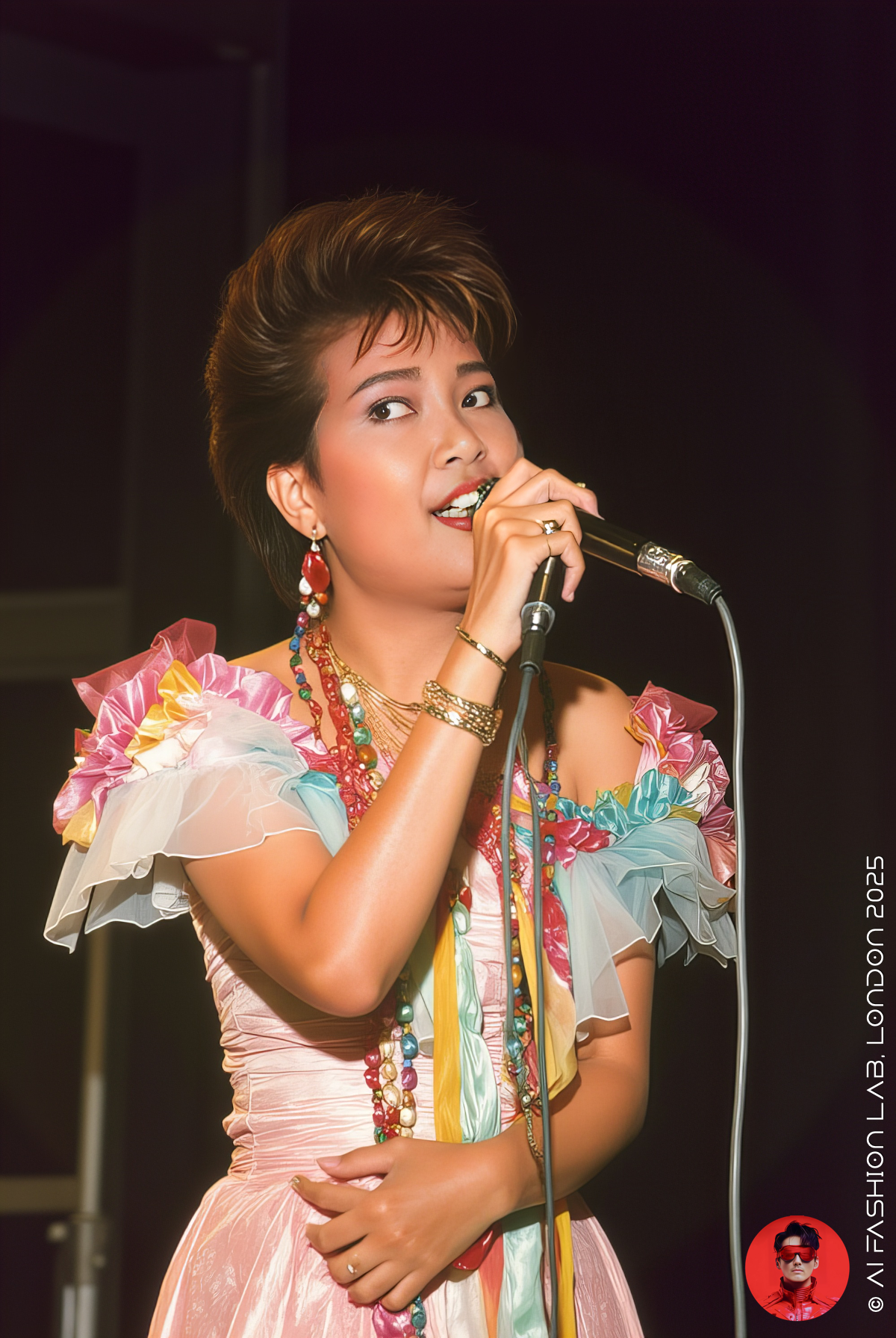พุ่มพวง ดวงจันทร์ ศิลปินลูกทุ่งหญิงผู้เปี่ยมด้วยแรงบันดาลใจเหนือกาลเวลา
พุ่มพวง ดวงจันทร์ ในจินตนาการ - ศิลปินลูกทุ่งหญิงผู้สร้างแรงบันดาลใจตลอดกาล
คอลเลกชัน AI นี้คือการรำลึกและอุทิศแด่ ‘แม่ผึ้ง – พุ่มพวง ดวงจันทร์’ ศิลปินลูกทุ่งผู้เปี่ยมด้วยแรงบันดาลใจเหนือกาลเวลา
คอลเลกชันภาพนี้ ขอมอบแด่ “พุ่มพวง ดวงจันทร์” หรือที่คนไทยทั้งประเทศต่างเรียกขานด้วยความรักว่า “แม่ผึ้ง” ศิลปินลูกทุ่งหญิงผู้เปล่งประกายและเปลี่ยนโฉมวงการเพลงลูกทุ่งไทยไปตลอดกาล ไม่เพียงแค่บทเพลงที่ไพเราะจับใจ หากแต่เธอคือครูผู้ยิ่งใหญ่ ผู้วางรากฐานศิลปะการร้อง การแสดง และการเป็นศิลปินอย่างแท้จริงให้กับศิลปินรุ่นหลังนับไม่ถ้วน
คอลเลกชัน AI นี้ คือการคารวะแด่ยุคทองของแม่ผึ้งในช่วงทศวรรษ 2520–2530 ซึ่งถือเป็นช่วงที่แม่ผึ้งได้รับความนิยมทั่วประเทศ ทั้งบทเพลง การแสดง และแฟชั่นของยุค 80s ผมได้นำแรงบันดาลใจจากชุดที่ใช้ในการแสดงของแม่ผึ้ง วงดนตรี และเหล่าหางเครื่องในยุคนั้น มาตีความใหม่ด้วยกลิ่นอายแห่งยุค 80s ผสานกับการขัดเกลารายละเอียดให้ประณีตขึ้น ทั้งการออกแบบทรงผม เครื่องประดับ การใช้ผ้าเมทัลลิก เลื่อม และซิลูเอตต์แบบ 80s ที่ยังคงกลิ่นอายความสนุกแบบโชว์ลูกทุ่ง
ผมยังจำได้ดีเมื่อตอนเป็นเด็กในยุค 1980s บ้านป้าและบ้านข้าง ๆ มักจะเปิดเพลงแม่ผึ้งจากเทปคาสเซ็ตดังไปทั้งซอย เด็ก ๆ อย่างพวกเราก็จะเต้นเลียนแบบนักร้องนักเต้นในวงของแม่ผึ้งกันอย่างสนุกสนาน โดยหยิบเสื้อของป้าในยุคนั้นมาใส่ เสื้อบ่าตั้งใหญ่ ๆ ซึ่งกลายเป็นเครื่องแต่งกายเฉพาะกิจที่เราคิดว่ามัน "ลูกทุ่งที่สุด" แล้ว และทุกปีในวันเด็ก โรงเรียนก็ต้องมีการแสดงเต้นประกอบเพลงของแม่ผึ้งเสมอ—ที่ผมจำได้แม่นที่สุดคือเพลง “ตั๊กแตนผูกโบว์” เพราะได้ขึ้นเวทีเต้นตอนอยู่ ป.3 หรือ ป.4 นี่แหละ เป็นภาพความทรงจำที่ยังอบอุ่นอยู่ในหัวใจจนถึงทุกวันนี้
เพลงของแม่ผึ้ง ไม่เพียงแต่สร้างความบันเทิง หากแต่เป็น “ตำราเรียน” ทางดนตรีลูกทุ่งที่ศิลปินทุกคนล้วนเคยเปิดอ่าน ไม่ว่าจะเป็นบทเพลงเร็วอย่าง ผู้ชายในฝัน, หนูไม่รู้, กระแซะเข้ามาซิ ที่กลายเป็นเพลงอมตะของทุกเวทีงานวัด ไปจนถึงเพลงช้าที่บีบหัวใจและเผยความสามารถด้านเสียงร้องระดับตำนานอย่าง นักร้องบ้านนอก, สาวนาสั่งแฟน และ ดาวเรืองดาวโรย ทุกเพลงล้วนสะท้อนให้เห็นถึงหัวใจของผู้หญิงคนหนึ่งที่เปล่งเสียงจากชีวิตจริง
แม้พุ่มพวงจะไม่ได้อ่านออกเขียนได้ แต่กลับเป็นศิลปินเพียงไม่กี่คนที่สามารถบันทึกเสียงเพลงโดยไม่ต้องใช้เนื้อร้อง ความสามารถในการจำจังหวะ ทำนอง และถ่ายทอดออกมาได้อย่างไร้ที่ติ กลายเป็นปาฏิหาริย์ทางดนตรีที่ครูเพลงหลายคนกล่าวขาน และเป็นสิ่งยืนยันว่า “พรสวรรค์” มีอยู่จริง
แม่ผึ้งยังเป็นศิลปินลูกทุ่งคนแรกที่ทะลุกำแพงเพลงบ้าน ๆ สู่เวทีระดับประเทศและระดับนานาชาติ ไม่ว่าจะเป็นการแสดงบนเวทีโลกดนตรี หรือการร้องเพลงถวายหน้าพระที่นั่ง ณ โรงแรมดุสิตธานี ปี พ.ศ. 2529 ทั้งหมดนี้ คือช่วงเวลาสำคัญในประวัติศาสตร์เพลงลูกทุ่งไทยที่ไม่มีวันเลือนหาย
คอลเลกชัน AI นี้จึงไม่ใช่เพียงการรำลึกถึงศิลปินระดับตำนานเท่านั้น หากแต่เป็นการนำเสนอมรดกทางวัฒนธรรมผ่านแฟชั่นและการแสดงในยุคที่แม่ผึ้งประสบความสำเร็จที่สุด — ยุคทองแห่งทศวรรษ 2520 ที่มีเพลงของแม่ผึ้งอยู่ในความทรงจำของคนไทย
ผมหวังว่าภาพชุดนี้จะเป็นอีกหนึ่งบทบันทึกที่ช่วยให้คนรุ่นใหม่ได้เห็นแม่ผึ้งอีกครั้ง ผ่านการตีความใหม่กับแฟชั่นในยุค 1980
ขอกราบสดุดี “พุ่มพวง ดวงจันทร์” ศิลปินของแผ่นดิน ผู้เป็นดวงจันทร์แห่งวงการลูกทุ่งไทยตลอดกาล
Poompuang Duangjan – The Timeless Inspiration of Thai Country Music
This AI collection is a remembrance and dedication to “Mae Phueng” – Poompuang Duangjan, a legendary Thai luk thung (country) singer whose influence transcends generations. Often lovingly referred to by the entire nation as “Mae Phueng,” Poompuang was more than just a singer with a captivating voice—she was a pioneering figure who transformed the face of Thai country music forever. Her artistry, charisma, and innovative spirit laid the foundation for modern luk thung performance, vocal style, and showmanship, serving as a guiding light for countless younger artists.
This AI tribute celebrates the golden era of her career during the 1980s (B.E. 2520s–2530s), a time when Poompuang reached the height of her fame across the country. The collection draws inspiration from her iconic performance costumes, the outfits of her band, and the dancers who shared the stage with her. Reimagined with a polished touch, the designs pay homage to the glamour of the 1980s—complete with voluminous hairstyles, glimmering metallic fabrics, sequins, shoulder pads, and the bold silhouettes that define the joy and energy of luk thung stage shows of the time.
I still remember vividly being a child in the 1980s—my aunt and the neighbours would play Poompuang's songs on cassette tapes that echoed down the soi (alleyway). We children would dress up in our aunties’ oversized shoulder-padded blouses and dance like her stage performers, improvising with whatever we could find. At school, Children's Day performances almost always featured dance routines to her songs. What I remember most was dancing to Takkatæn Phuk Bow (The Grasshopper Tied with a Bow) when I was in Primary 3 or 4—it’s a memory that still warms my heart to this day.
Poompuang’s music was not merely entertainment—it was a “textbook” of luk thung. Her upbeat classics like Phuchai Nai Fan (The Man of My Dreams), Nu Mai Ru, and Krasae Khao Ma Si became anthems at local festivals and school fairs, while her emotional ballads like Nak Rong Ban Nok, Sao Na Sang Faen, and Dao Rueang Dao Roy showcased her vocal mastery and the heartfelt truth of rural life, sung by someone who lived and breathed it.
Despite being unable to read or write, Poompuang possessed a musical memory so powerful that she could record entire songs without looking at a single lyric sheet—an astonishing feat that many veteran songwriters recall as nothing short of a miracle. Her natural gift for rhythm, melody, and expression proved that true talent could overcome any barrier.
She was also the first luk thung artist to break away from the “old-fashioned” image of the genre, bringing Thai country music to the national and even international stage. Her performance on the famed "Loke Dontri" (World of Music) programme and her royal charity concert at the Dusit Thani Hotel in 1986—where she sang sixteen songs in a single set—marked historic moments not just in her career, but in the evolution of Thai popular music itself.
This AI collection is not merely a tribute to a legendary artist, but also a cultural preservation project. It presents the aesthetic and performance essence of Mae Phueng’s peak era—the golden 1980s (B.E. 2520s)—a time when her music echoed in every corner of Thailand.
Through this reinterpretation, I hope younger generations can reconnect with the spirit of Poompuang Duangjan, experiencing her once more through the lens of fashion, style, and memory—reimagined for today, but never forgetting yesterday.
#aifashionlab #AI #aiartist #aiart #aifashion #aifashiondesign #aifashionstyling #aifashiondesigner #fashion #fashionhistory #historyoffashion #fashionstyling #fashionphotography #digitalfashion #digitalfashiondesign #digitalcostumedesign #digitaldesign #digitalaiart #ThaiFashionHistory #ThaiFashionAI #flux #fluxlora










































